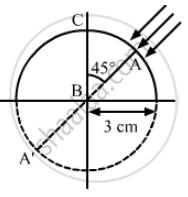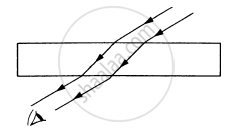Advertisements
Advertisements
प्रश्न
Figure shows a transparent hemisphere of radius 3.0 cm made of a material of refractive index 2.0. (a) A narrow beam of parallel rays is incident on the hemisphere as shown in the figure. Are the rays totally reflected at the plane surface? (b) Find the image formed by the refraction at the first surface. (c) Find the image formed by the reflection or by the refraction at the plane surface. (d) Trace qualitatively the final rays as they come out of the hemisphere.

उत्तर
Given,
The radius of the transparent hemisphere (R) = 3.0 cm
Refractive index of the material (μ2) = 2.0
Let the critical angle be θc
∴ critical angle is given by θc = \[\sin^{- 1} \left( \frac{1}{\mu_2} \right) = \sin^{- 1} \left( \frac{1}{2} \right) = 30^\circ\]
(a)
From the figure it is seen that the angle of incidence is greater than the critical angle, so the rays are totally reflected at the plane surface.
(b) Using the lens equation:
\[\frac{\mu_2}{v} - \frac{\mu_1}{u} = \frac{\mu_2 - \mu_1}{R}\]
\[ \Rightarrow \frac{2}{v} - \left( - \frac{1}{\infty} \right) = \frac{2 - 1}{3} (\text{ for parallel rays u = \infty })\]
\[ \Rightarrow \frac{2}{v} = \frac{1}{3}\]
\[ \Rightarrow v = 6 cm\]
If we complete the sphere then the image will be formed diametrically opposite to A.
(c)
By internal reflection, the image is formed in front of A.
APPEARS IN
संबंधित प्रश्न
A diver under water, looks obliquely at a fisherman standing on the bank of a lake. Would the fisherman look taller or shorter to the diver than what he actually is?
Does the apparent depth of a tank of water change if viewed obliquely? If so, does the apparent depth increase or decrease?
Determine the value of the angle of incidence for a ray of light travelling from a medium of refractive index \[\mu_1 = \sqrt{2}\] into the medium of refractive index \[\mu_2 = 1\] so that it just grazes along the surface of separation.
A glass lens of refractive index 1.45 disappears when immersed in a liquid. What is the value of refractive index of the liquid?
Why does a diamond shine more than a glass piece cut to the same shape?
A narrow beam of light passes through a slab obliquely and is then received by an eye following figure. The index of refraction of the material in the slab fluctuates slowly with time. How will it appear to the eye? The twinkling of stars has a similar explanation.

A laser light is focussed by a converging lens. Will there be a significant chromatic aberration?
A narrow beam of white light goes through a slab having parallel faces.
(a) The light never splits in different colours
(b) The emergent beam is white
(c) The light inside the slab is split into different colours
(d) The light inside the slab is white
The refractive index of a material changes by 0.014 as the colour of the light changes from red to violet. A rectangular slab of height 2.00 cm made of this material is placed on a newspaper. When viewed normally in yellow light, the letters appear 1.32 cm below the top surface of the slab. Calculate the dispersive power of the material.
A pole of length 1.00 m stands half dipped in a swimming pool with water level 50.0 cm higher than the bed. The refractive index of water is 1.33 and sunlight is coming at an angle of 45° with the vertical. Find the length of the shadow of the pole on the bed.
Consider the situation in figure. The bottom of the pot is a reflecting plane mirror, S is a small fish and T is a human eye. Refractive index of water is μ. (a) At what distance(s) from itself will the fish see the image(s) of the eye? (b) At what distance(s) from itself will the eye see the image(s) of the fish.

Why do stars twinkle?
Obtain the equation for critical angle.
Write a short note on the prisms making use of total internal reflection.
A ray of light travels from air to water to glass and aga in from glass to air. Refractive index of water with respect to air is 'x' glass with respect to water is 'y' and air with respect to glass is 'z'. which one of the following is correct?
When a light ray is incident on a prism at an angle of 45°, the minimum deviation is obtained. If refractive index of material of prism is `sqrt2`, then angle of prism will be ______.
`sin pi/4=1/sqrt2, sin30^circ=cos60^circ=1/2`
For a rectangular slab, refraction takes place at ______.
Light travels in two media A and B with speeds 1.8 × 108 ms−1 and 2.4 × 108 ms−1 respectively. Then the critical angle between them is:
Three immiscible liquids of densities d1 > d2 > d3 and refractive indices µ1 > µ2 > µ3 are put in a beaker. The height of each liquid column is `h/3`. A dot is made at the bottom of the beaker. For near normal vision, find the apparent depth of the dot.
A beam of light travels from air into a medium. Its speed and wavelength in the medium are 1.5 × 108 ms-1 and 230 nm respectively. The wavelength of light in the air will be ______.
